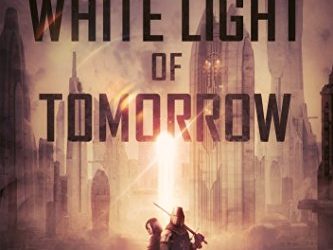About the book, The White Light of Tomorrow 
- Print Length: 277 pages
- Publisher: D. Pierce Williams (May 1, 2017)
In a future dominated by the Church and defended by the sword, one piece of forbidden technology may change all the rules.
Adrian of Tarsus is a veteran Knight Hospitaler. His adopted daughter, Mariel, serves as his squire, and together they travel the galaxy aboard the ancient merchant ship Miranda. Adrian uses his position as a Church enforcer to provide cover for his real quest: a cure for Mariel’s mysterious and painful illness, which worsens every day.
Trouble is, Adrian’s certain the cure requires Machina Infernus, heretical technology forbidden by the Church, and not even a Knight can hide from the Holy Office of the Universal Inquisition.
When the Miranda’s crew are ambushed while acquiring such an object, Adrian turns to Sabine Adler, an old flame and specialist in Machina, for help.
But once on the planet Bethany, Sabine’s home and the seat of Christendom, assassins come out of the woodwork and everyone seems to want Adrian’s relic –mercenaries, cultists, thugs, politicians, even the Inquisition. Most troubling of all are a pair of unusual nuns who claim to know the location of the lab where the relic originated, and the fact that one of them bears a striking resemblance to Mariel.
Adrian has survived galactic crusades, skilled assassins, and Church politics, but these women may be the death of him.
Buy, read, and discuss The White Light of Tomorrow
Amazon | Barnes & Noble | Smashwords
About the author, D. Pierce Williams 
I am a computer geek, history nut, aviation enthusiast, and very efficient procrastinator. I play tabletop role-playing games (Dungeons & Dragons, Shadowrun, White Wolf, etc.) like it’s 1989. I like to listen to Bach, Van Halen, and Snoop Dogg in that order. I loves dogs. All of them.
I studied history in college and graduated cum laude with a BA in 1997. The focus of my study was modern European history with emphasis on the period from approximately 1850 to 1950, covering industrialization, the rise of nationalism, fascism and communism, and the world wars.
I entered a History Master’s program in the fall of ’97. For reasons having everything to do with money, I left the program and instead completed an MBA focusing on information technology management. I graduated from this program in 2000. From 1999 onward I’ve pursued a successful career in IT, and worked as a network and systems engineer for a Fortune 100 life-insurance and retirement services company for the past ten years.
Since 2013 I’ve been working hard on this, THE WHITE LIGHT OF TOMORROW, my first novel, which draws on my interest in science fiction and my love of history and technology.
Connect with D. Pierce Williams:
My Thoughts
“I’m reading this great book,” I told my husband. “It’s got elements of history, science fiction, and high fantasy.”
“Oh, really?” he asked, his entire face lighting up with interest. “It sounds like something I might enjoy.”
And so even before this review goes live, I’ve put this novel, The White Light of Tomorrow into another reader’s hands. Go, me!
Seriously though, D. Pierce Williams’ debut offering is a compelling read.
The tone is best described as Firefly meets the Renaissance, but that’s an over-simplification, because the author, a self-described history nut, has clearly done a lot of research to make the world of this book feel, not just vivid and dimensional, but wholly original. When Sabine was complaining about her shoes, in the first scene where we meet her, I was so into the story that my feet hurt in sympathy. I could hear the noise of her pub, and, in street scenes, I could feel dirt roads beneath my feet. At the same time, when I realized the ship that Adrian and Mariel call home was a space-going vessel, I was pleasantly surprised (this despite having read the description and the marketing materials for the book).
I really liked the mix of historic society – swords and cloaks and taverns – with bits of technology – space ships and DNA drives, and I found that the author meshed these seemingly disparate cultures into a cohesive one very believably. I also appreciated the diversity of his characters. Not only were women well represented, but not every major character was a middle-class white guy. Instead, there was a realistic and plausible blend of people from all levels of education, wealth, and nationality. This is something that contemporary speculative fiction often has trouble with, and there’s a line between having believable diversity and making the cast of characters feel like a Very Special Episode of some drama.
I don’t generally tell people who my favorite characters are, but something about Mariel, who is roughly fourteen when we meet her, really resonated with me. I think it was the combination of her spunk, and the way she essentially created her own family.
As aspiring writers, we are often admonished to ‘write what you know,’ which is difficult when you’re writing a piece that doesn’t take place on contemporary (or near-contemporary) Earth. With The White Light of Tomorrow, it’s clear that author Williams has taken all the things he knows and loves – history, science fiction, aviation – and woven them together into a story that tickles the imagination and makes you beg for more.
It’s implied that this book is meant to be the first of a series; I eagerly await the subsequent volumes.
Goes well with pub food: fish and chips or shepherd’s pie and a pint of ale.

